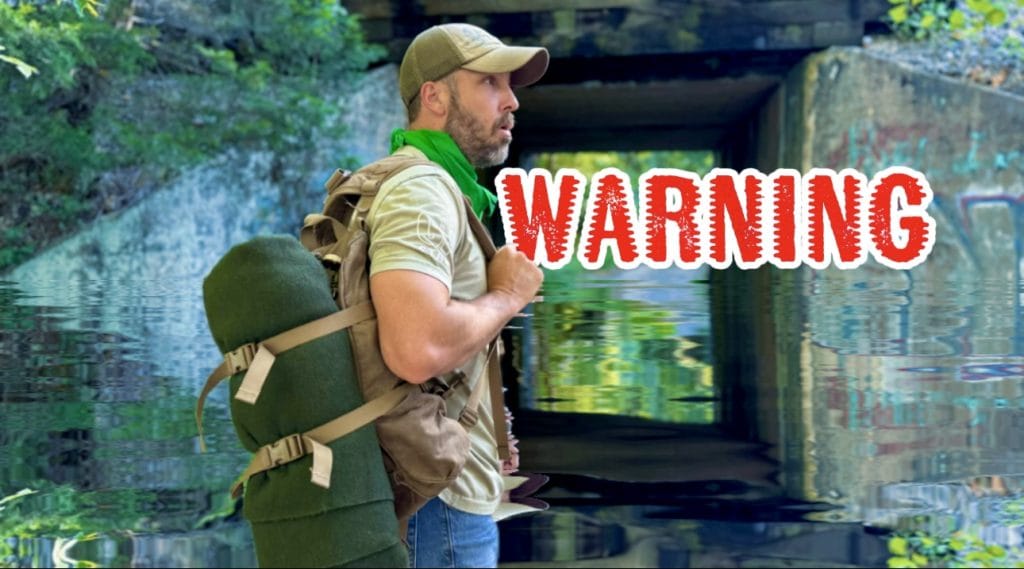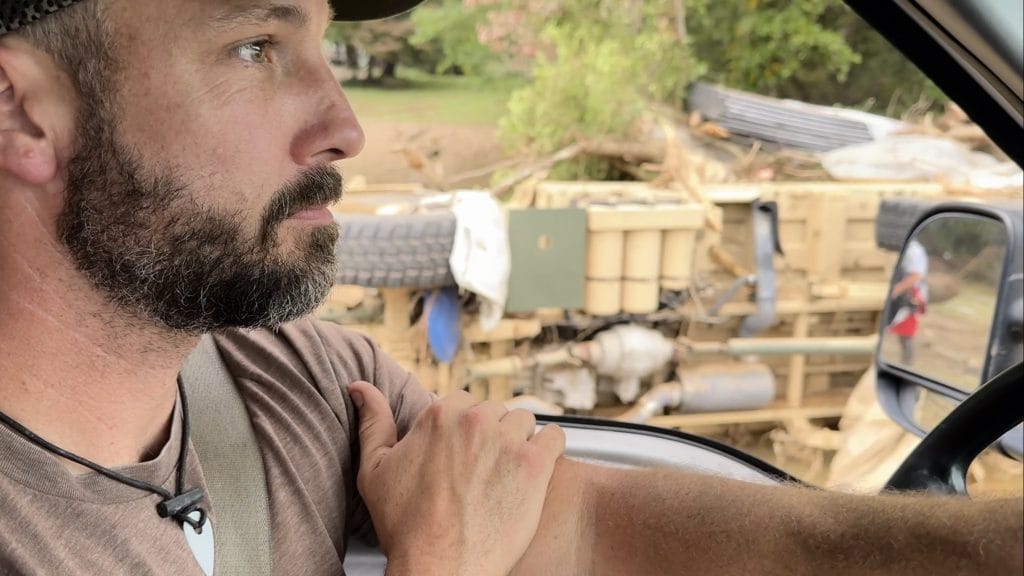
Standing next to a peaceful Georgia river last week, I watched the calm water flow by and remembered something that still disturbs me. This exact same type of serene stream had turned into a raging monster that claimed lives during Hurricane Katrina and Helene. Flash flood survival isn't just another prepper topic it's life or death knowledge that every family needs.
Twenty years ago, Hurricane Katrina swallowed New Orleans. Entire neighborhoods disappeared beneath the water, nearly 1,400 lives were lost, and the nation saw firsthand how fast rising floods can destroy everything. Fast-forward to Hurricane Helene, one of the deadliest storms since Katrina and families across the Southeast once again found themselves climbing onto rooftops, rivers swallowing homes, and loved ones swept away by flash floods that came faster than anyone could run.
Flash floods don’t just happen in massive hurricanes, they can strike almost anywhere heavy rain falls. They remain one of America’s deadliest storm hazards. One wrong turn down a flooded road, one hesitation to move to higher ground, and the outcome can be fatal.
As families head out this Labor Day weekend, the warning couldn’t be clearer: water rises faster than you can imagine, and in the wrong place at the wrong time, it can take everything from you in seconds.
The National Weather Service had just issued flash flood warnings across Arkansas, Alabama, Mississippi, and Louisiana. When I recorded my Flash Flood Survival Video, it got me thinking about how unprepared a lot of families are for this silent killer. What people perceive as basic knowledge really isn't so basic for a lot of people. Flash floods kill more people in the United States every single year than lightning, more than hurricanes, and more than tornadoes.
A lot of people think they know what to do in a flash flood or worse, they’ve never even thought about it. It’s something every single one of us needs to take seriously. Especially with rising numbers of flash floods that are occurring.
A few years ago my wife and I were out West exploring a place that felt like stepping back in time. The road was narrow, muddy, and already slick from light rain. Even in my massive Ford F-350, the truck was starting to slide in the mud. I understood exactly what those signs meant and how quickly conditions could turn, even with just a little rain. My wife didn’t realize the danger, and after the long drive to reach those incredible dinosaur footprints, she begged me to press on. My instincts and knowledge told me otherwise. Thank God I listened. We turned around just in time, barely escaping before the floodwaters tore through.
Keep reading because knowing how to spot the signs and what to do in the moment can mean the difference between survival and tragedy
According to Ready.gov and FEMA, all it takes is six inches of moving water to knock a grown adult off their feet. That's a fact I've experienced firsthand. When I was out surfing in the ocean years ago, I learned real quick about the force of water. What you try not to do is get the surfboard between you and the wave. If you let the wave hit you first, then the surfboard, you're generally okay. But if you're standing and a wave hits that surfboard against you, it's like getting hit by a car. Ouch!
Most people underestimate the power of water. They think "What's the worst that can happen?" which is oftentimes what I say but you've got to listen to your instincts. If your instincts are saying stay away from that flooded road, then listen to those instincts.
While volunteering after Hurricane Helene devastated parts of North Carolina, we met a man who had lost his entire two-story home when a river, normally calm and harmless, swelled into a raging force and swept it completely away. With tears in his eyes, he told us about his neighbors, parents of twin boys, who tragically didn’t survive. In a desperate attempt to escape, they drove into the floodwaters, not realizing how deceptively powerful and dangerous even shallow-looking water can be.
This man made a different choice. He abandoned everything, grabbed his dogs, and leapt across a torrent that had once been his quiet backyard creek. On the other side, he climbed to the higher ground where he had wisely parked his car in preparation for the worst. That decision ultimately saved his life. While his neighbors, heartbreakingly, did not make it.
Here's what makes flash floods so deadly: they can transform a calm stream into a raging torrent that's 10 or 15 feet over your head in a very short period of time. The speed depends on rainfall volume, dam conditions upstream, and dozens of other factors. Most people don't realize how fast the water can come up, it's literally seconds in some cases.
Take that water up to 12 inches, and a small car trying to cross can get washed downstream. When you get to two feet of moving water, it doesn't matter what you're driving. The water pushes against those tires, against the wheels, and eventually touches the doors. It's a tremendous amount of force that most vehicles simply can't overcome.
I had a buddy try to cross a river in his Toyota Tacoma. The water was probably about a foot and a half deep, give or take. He thought, "Ah, no problem, I'll make it." His truck got swept up by the water, the back end got pushed around, then downstream, and finally lodged up against a big tree on the riverbank. Totaled his truck essentially, flooded it completely. That was just 18 inches of moving water.
FEMA has a phrase "Turn around, don't drown." If you're in your vehicle approaching a flooded road, just turn around. It's not worth it, even if you've got a big SUV, four-wheeler, or jacked-up truck with a snorkel. It's really not worth losing your vehicle or potentially your life. To be clear, I am not a fan of FEMA but they do offer a bit of valuable information.
As fast as floodwaters can rise, they can also recede. Generally, you’re not going to be stranded on a hillside forever. The water comes up quickly and goes down quickly.
Picture the sheer weight of a fire hose blasting full force. That’s the kind of pressure rushing water puts against a car door. There’s no way you’re going to muscle through that kind of force. You might manage to break a window, but if your vehicle gets pinned against a riverbank, bridge, or debris, escaping becomes very difficult.

Having alternative routes is crucial for flood preparedness tips. Here's your action plan:
• Map out 2 to 3 different routes to work, home, or school
• Keep paper maps in your vehicle and home
• Scout and drive these routes ahead of time
• Memorize key landmarks and turn points
• Identify higher ground routes when possible
Don't rely solely on GPS because cell towers go down during disasters, as we saw extensively during Hurricane Helene.
Want more tips on Survival and Prepping then join my Substack https://on3ready.substack.com/
You should definitely pay attention to severe weather alerts on your phone, but don't count on them. Just because you haven't received an alert doesn't mean a flash flood isn't coming your way. During Hurricane Helene, lots of people had no cell phone coverage because towers were down.
Having backup forms of communication is essential. Here's what you need:
• Handheld radio with recharged batteries for emergency stations
• Hand crank radio that works without power
• NOAA weather radio for national alerts
• Extra batteries stored properly
These systems work when cell phone towers and internet are down. This is non negotiable emergency flood planning equipment.
If you live in any possible flood area, protect your critical documents:
• Store important papers on upper floors or high shelves
• Keep vehicle titles, insurance papers, birth certificates above potential water line
• Avoid basement storage for anything irreplaceable
• Create digital copies on waterproof thumb drives
• Upload copies to secure cloud storage services
• One small flash drive can hold your entire family's documents
Even minor flooding can soak up walls and destroy important documents, creating massive headaches later.
Flood water is incredibly contaminated with septic overflow, chemicals, oil, and debris. Here's your water safety plan:
• Install a quality home filtration system like Berkey
• Keep water purification tablets as backup
• Have large pots for boiling water
• Store unscented bleach for emergency purification
• Maintain water bottles and storage containers for clean water reserves
• Keep collapsible water containers for emergency collection
• Test multiple filtration methods before you need them
I keep a Grayl water filter in my pack because I trust them. I've used them all over the world and never gotten sick, even drinking from questionable sources.
Ready to upgrade your water filtration game? Check out my gear recommendations for tested, reliable options. On3 Amazon Storefront

Vehicle fuel management can save your life:
• Never let your tank drop below a quarter tank
• Quarter tank equals empty in emergency situations
• Top off before severe weather hits
• Beat the crowds by being proactive
• Most vehicles can travel 100+ miles on a quarter tank
If you know there's a hurricane or possible floods coming your way, top off that fuel tank before the lines get crazy. Be the first one there. Be proactive instead of reactive.
Park your vehicle on higher ground when possible, so you don't have to worry about floodwaters damaging or taking it away. Keep a go bag in your vehicle along with specific emergency supplies like jumper cables and basic tools.
Having a bag packed and ready to go saves time, chaos, and worry about what you might need when floodwaters are threatening your home. I keep a vehicle bag which covers the basics: food, water, fire, shelter, security, first aid and communications. My go bag that's by my door is a redundancy of that but with more details.
Keep these essentials in your vehicle at all times:
• Food: Energy bars, MREs, or shelf stable meals
• Water: Bottled water plus filtration method
• Fire: Waterproof matches, lighter, fire starter
• Shelter: Emergency blanket, poncho, or tarp
• Security: knife, firearm
• First Aid: Basic trauma kit with bandages and medications
• Communications: Phone, Hand held radio, extra batteries, power bank, charging cables
Don't forget to store all the other vehicle emergency supplies in your car like jumper cables.
Your Home Go Bag/ Bugout Bag should be more comprehensive with these vital items:
• 72 hours PLUS of food per person (lightweight, high calorie, ready to eat)
• Water purification tablets and portable filter
• Fire starting kit with multiple ignition methods
• Emergency shelter materials (bivvy, tarp, cordage)
• Self defense tools and signaling devices
• Advanced first aid supplies including prescription medications
• Communication devices with backup power sources
• Important documents in waterproof container
• Cash in small bills for emergencies
• Extra clothing appropriate for season
Keep it by your front door, ready to rock at a moment's notice.
Want the complete Ultimate Preparedness Checklist that comes from decades of Survival and Preparedness experience? Join my Substack. Paid subscribers get detailed packing lists and gear recommendations.
How much water does it take to float a car? Just 12 inches of moving water can wash away a small car. At two feet of fast-moving water, any vehicle can be swept away regardless of size or type.
What should I do if I'm trapped in a flooding vehicle? If possible, abandon the vehicle immediately and move to higher ground. Don't try to drive through flood water. If already trapped, try to break windows and escape to the roof, but prevention through route planning is always better.
How fast can flash floods develop? Flash floods can develop in minutes, transforming calm streams into deadly torrents. The speed depends on rainfall intensity, terrain, and upstream conditions like dam releases.
What documents should I protect from flood damage? Keep vehicle titles, insurance papers, birth certificates, passports, social security cards, and financial documents on upper floors. Create digital backups on waterproof storage devices.
How can I receive flood warnings without cell service? NOAA weather radios, hand crank radios, and emergency broadcast systems work independently of cell towers. Battery powered or hand crank radios ensure you can receive warnings even during power outages.
What's the safest place to be during a flash flood? Higher ground is always safest. If flooding threatens your home, abandon material possessions and move to elevated areas. Never shelter in vehicles or basements during flash flooding.
How contaminated is flood water? Flood water contains sewage, chemicals, oil, debris, and dangerous bacteria. Never drink untreated flood water, and avoid contact when possible. Always have multiple water purification methods available.
The difference between life and death often comes down to preparation and quick decision-making. That man in North Carolina survived Hurricane Helene's devastating floods because he made the hard choice to abandon his home and get to higher ground. His neighbors who tried to shelter in vehicles didn't make it.
Flash flood survival isn't about having the biggest truck or the most expensive gear. It's about respecting the power of water, planning alternative routes, keeping emergency supplies ready, and making smart decisions under pressure. Most importantly, it's about listening to your instincts when they tell you to stay away from dangerous situations.
Water is incredibly powerful, and most people underestimate it until it's too late. That peaceful stream can become a killer in minutes. But with proper preparation, route planning, and the right mindset, you can keep your family safe when nature shows its violent side.
Start today by identifying alternative routes from your home, workplace, and school. Pack that go bag with the seven essentials. Test your communication backup systems. Store important documents safely. These aren't complicated steps, but they're the difference between being a victim and being a survivor.
What's your family's biggest vulnerability when it comes to flash flood threats? Are you prepared to make the tough decisions that could save lives when seconds count?
Ready to take your preparedness to the next level? Join my Substack community where we dive deep into real-world survival scenarios and practical family preparedness strategies.
Jason Salyer is the creator and host of the "On Three" brand, specializing in practical survival, bushcraft, and family preparedness. With military experience and field-tested expertise, Jason provides no-nonsense advice for real-world situations. Based in Georgia, he combines Southern wisdom with tactical knowledge to help families prepare for whatever challenges come their way. His philosophy centers on practical preparedness without fear-mongering, empowering people to take control of their family's safety and resilience.
Explore the gear and supplies I personally use and trust. When you purchase through my Amazon storefront and other affiliates I earn a small commission at no extra cost to you. These small commissions help support the creation of informative free content for you to enjoy.

